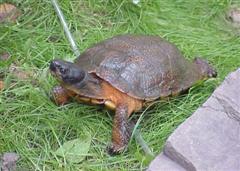Wood Turtle - North American
Scientific Name: Clemmys insculpta
Tue, 15th July, 2025 - 9:23 pm GMT
Sponsor Ads:

Alternative Name
Scientific Name: Clemmys insculptaBasic Info
A moderately sized turtle, the North American Wood Turtle averages between 5 1/2 and 8 inches in length. They are called "Wood Turtles" not because of their habitat, but because it was thought that their shell resembled in both appearance and texture a piece of wood. The rough shell has growth rings on the scutes and keels, or raised ridges, that move from the center outward. Some Wood Turtles have yellow keels, but they are usually unmarked. The upper shell, or carapace, is usually dark brown in color and the plastron is yellow with black markings. The majority of the Wood Turtle's skin is brown, although the neck is yellow or orange. Male Wood Turtles can be distinguished from females because of their larger size, larger heads, concave plastrons (under shell), and longer tails. Hatchling North American Wood Turtles are less than two inches long and are usually brown or gray.
Health
Breeding Male and female Wood Turtles often engage in a courtship ritual that involves swinging their heads at each other. When the female is receptive, the male mounts her, usually in shallow water. They are most likely to mate in spring and fall, although they can mate at any time they are not hibernating. After mating, usually in the early summer, the female turtles build a nest in a sunny, sandy bank near water. She can only produce one clutch, usually consisting of between 5 and 13 eggs, per year. Most eggs fall prey to raccoons, shrews, skunks, and other animals. Eggs hatch after between 47 and 69 days of incubation. It is reported that unlike most turtles, the sex of the hatchling is not dependent on the temperature of incubation. It is estimated that fewer than 30% of the Wood Turtle eggs laid hatch each year.Habitat
Found in eastern Canada (Nova Scotia and New Brunswick) and the northeastern United StatesBehavior
The diurnal North American Wood Turtle is a moderately sized, docile creature. Like most other turtles, they are rather shy. If kept in the proper environment, they can become excellent pets. The North American Wood Turtle spends much of its day foraging for food. They are semi-aquatic and capable of eating in and out of the water.Some groups of North American Wood Turtles are believed to lure earthworms out from the ground by pounding the ground with their feet or shell. It is thought that the earthworms mistake the pounding for a mole's approach or thunder and come to the surface to escape the threat or enjoy the rain. The turtle then, of course, eats them. Any time that the North American Wood Turtle does not spend searching for food, they spend basking. They are used to the cold temperatures found in much of their range, and use the sun to warm up. While adapted to cold weather, they cannot withstand the frigid temperatures of a midwestern winter and instead hibernate throughout the season. They usually burrow on the bottom of the streams or rivers where they make their home, where the water cannot freeze. Even when not hibernating, the North American Wood Turtle rarely ventures out of its stream and generally stays within 2.5 and 15 acres of where it was born, its entire life. North American Wood Turtles are rather intelligent and in laboratory tests were found to perform as well as rats on mazes. The North American Wood Turtle is very adaptable and can be found in a variety of habitats. Its capacity to live in a wide range of environments, including streams, creeks, rivers, woods, thickets, meadows, and swamps, may add to the perception of humans that the Wood Turtles are very smart.Origin
North AmericaHistory
North American Wood Turtles can be found in eastern Canada (Nova Scotia and New Brunswick) and the northeastern United States. In the United States, they can be found in New England, northern New Jersey, Pennsylvania, south to northern Virginia, northern Michigan, Wisconsin, eastern Minnesota, and northeastern Iowa. In Canada, they are common in Nova Scotia, New Brunswick, southern Quebec, and southern Ontario. North American Wood Turtles used to be highly valued as a food source for humans. They were also thought to have medicinal value. Unfortunately, it is rather difficult to find North American Wood Turtles in their native habitat today because they are being collected and exploited for the pet trade.Common Foods
In the wild, they have been observed eating flowers, leaves, and plants including strawberries, violets, raspberries and willows, as well as berries, slugs, snails, insects, worms and fungi. They are slow moving, careful eaters and, while they will eat bSponsor Ads:
On the ONE day you take your secretary to lunch, your wife will be lunching in the same restaurant. -- Unknown
Wood Turtle - North American
Coded by: BGID® | ALL RIGHTS RESERVED Copyright © 2000-2025
Disclaimer | Privacy | Report Errors / Contact | Credits








 Preparing For China. China is growing their military. China Military Technology - can it keep up with the US?
Preparing For China. China is growing their military. China Military Technology - can it keep up with the US?  versus
versus 

 versus
versus 
 This Thread is about the North Korean Military itself - the kind of army, navy, and air force they have.
This Thread is about the North Korean Military itself - the kind of army, navy, and air force they have. 
 versus
versus 
 versus
versus  versus
versus